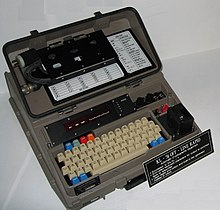KL-51
Appearance
This article includes a list of general references, but it lacks sufficient corresponding inline citations. (April 2015) |

The KL-51 is an off-line keyboard encryption system that read and punched paper tape for use with teleprinters. In NATO it was called RACE (Rapid Automatic Cryptographic Equipment).
It was developed in the 1970s by a Norwegian company, Standard Telefon og Kabelfabrik (STK). It used digital electronics for encryption instead of rotors, and it may have been the first machine to use software based crypto algorithms. KL-51 is a very robust machine made to military specifications.
U.S. National Security Agency bought it in the 1980s to replace the earlier KL-7. As of 2006, the U.S. Navy was developing plans to replace KL-51 units still in use with a unit based on a more modern Universal Crypto Device.[1]
References
- ^ "Archived copy" (PDF). Archived from the original (PDF) on 2011-05-22. Retrieved 2008-05-29.
{{cite web}}: CS1 maint: archived copy as title (link)
Sources
- NSA museum caption shown in photo.
- Crypto Machines - KL-51/RACE
- http://www.knobstick.ca/pdf_files/race1.pdf
